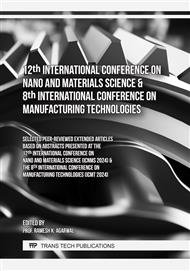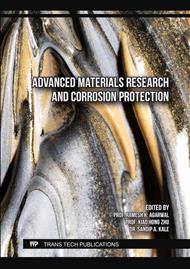[1]
A. Miriyev, et al., Interface evolution and shear strength of Al/Ti bi-metals processed by a spark plasma sintering (SPS) apparatus. Journal of Alloys and Compounds, 2016. 678: pp.329-336.
DOI: 10.1016/j.jallcom.2016.03.137
Google Scholar
[2]
R. Gupta, et al., Effect of chromium and niobium on the kinetics of synthesis of Titanium aluminide. Metal Science and Heat Treatment, 2013. 55(7-8): pp.438-444.
DOI: 10.1007/s11041-013-9651-3
Google Scholar
[3]
A. Ismaeel, and C.-s. Wang, Effect of Nb additions on microstructure and properties of γ-TiAl based alloys fabricated by selective laser melting. Transactions of Nonferrous Metals Society of China, 2019. 29(5): pp.1007-1016.
DOI: 10.1016/s1003-6326(19)65009-0
Google Scholar
[4]
W.E., Voice, et al., Gamma titanium aluminide, TNB. Intermetallics, 2005. 13(9): pp.959-964.
DOI: 10.1016/j.intermet.2004.12.021
Google Scholar
[5]
L. Wang, et al., Achieving the excellent self-lubricity and low wear of TiAl intermetallics through the addition of copper coated graphite. Composites Part B: Engineering, 2020. 198: p.108223.
DOI: 10.1016/j.compositesb.2020.108223
Google Scholar
[6]
P.C. Priarone, et al., Effects of cutting angle, edge preparation, and nano-structured coating on milling performance of a gamma titanium aluminide. Journal of Materials Processing Technology, 2012. 212(12): pp.2619-2628.
DOI: 10.1016/j.jmatprotec.2012.07.021
Google Scholar
[7]
N. Mizuta, et al., Titanium aluminide coating on titanium surface using three-dimensional microwelder. Materials Science and Engineering: A, 2008. 492(1-2): pp.199-204.
DOI: 10.1016/j.msea.2008.03.028
Google Scholar
[8]
F. Klocke, et al., High performance cutting of gamma titanium aluminides: Influence of lubricoolant strategy on tool wear and surface integrity. Wear, 2013. 302(1-2): pp.1136-1144.
DOI: 10.1016/j.wear.2012.12.035
Google Scholar
[9]
J. Cheng, et al., The tribological behavior of a Ti-46Al-2Cr-2Nb alloy under liquid paraffine lubrication. Tribology Letters, 2012. 46(3): pp.233-241.
DOI: 10.1007/s11249-012-9942-7
Google Scholar
[10]
K. Ronoha, et al., Evaluation of the Surface Roughness of Ti-6Al-4V for Surface Grinding under Different Cooling Methods Using Conventional and Vegetable Oil-based Cutting Fluids. 2019.
DOI: 10.24874/ti.2019.41.04.15
Google Scholar
[11]
X. Li, et al., Improved wear resistance and mechanism of titanium aluminum based alloys reinforced by solid lubricant materials. Materials Research Express, 2018. 5(8): p.086502.
DOI: 10.1088/2053-1591/aad125
Google Scholar
[12]
J. Cheng, et al., Effect of TiB2 on dry-sliding tribological properties of TiAl intermetallics. Tribology International, 2013. 62: pp.91-99.
DOI: 10.1016/j.triboint.2013.02.006
Google Scholar
[13]
D. Roy, B. Basu, and A.B. Mallick, Tribological properties of Ti-aluminide reinforced Al-based in situ metal matrix composite. Intermetallics, 2005. 13(7): pp.733-740.
DOI: 10.1016/j.intermet.2004.11.005
Google Scholar
[14]
M. Nofar, H.M. Hosseini, and N. Kolagar-Daroonkolaie, Fabrication of high wear resistant Al/Al3Ti metal matrix composite by in situ hot press method. Materials & Design, 2009. 30(2): pp.280-286.
DOI: 10.1016/j.matdes.2008.04.071
Google Scholar
[15]
P. Chandramohan, et al., Laser additive manufactured Ti–6Al–4V alloy: tribology and corrosion studies. The International Journal of Advanced Manufacturing Technology, 2017. 92(5): pp.3051-3061.
DOI: 10.1007/s00170-017-0410-2
Google Scholar
[16]
W. Chen, and Z. Li, Additive manufacturing of titanium aluminides, in Additive Manufacturing for the Aerospace Industry. 2019, Elsevier. pp.235-263.
DOI: 10.1016/b978-0-12-814062-8.00013-3
Google Scholar
[17]
G. Wegmann, et al., High-temperature mechanical properties of hot isostatically pressed and forged gamma titanium aluminide alloy powder. Intermetallics, 2002. 10(5): pp.511-517.
DOI: 10.1016/s0966-9795(02)00026-2
Google Scholar
[18]
M. Adeli, et al., A study on the combustion synthesis of titanium aluminide in the self-propagating mode. Journal of alloys and compounds, 2010. 497(1-2): pp.100-104.
DOI: 10.1016/j.jallcom.2010.03.050
Google Scholar
[19]
Z. Trzaska, A. Couret, and J.-P. Monchoux, Spark plasma sintering mechanisms at the necks between TiAl powder particles. Acta Materialia, 2016. 118: pp.100-108.
DOI: 10.1016/j.actamat.2016.07.043
Google Scholar
[20]
J. Dai, et al., Microstructure and high-temperature oxidation resistance of Ti-Al-Nb coatings on a Ti-6Al-4V alloy fabricated by laser surface alloying. Surface and Coatings Technology, 2018. 344: pp.479-488.
DOI: 10.1016/j.surfcoat.2018.03.060
Google Scholar
[21]
M. Eriksson, M. Radwan, and Z. Shen, Spark plasma sintering of WC, cemented carbide and functional graded materials. International Journal of Refractory Metals and Hard Materials, 2013. 36: pp.31-37.
DOI: 10.1016/j.ijrmhm.2012.03.007
Google Scholar
[22]
L. Liu, et al., Ultrafine grained Ti-based composites with ultrahigh strength and ductility achieved by equiaxing microstructure. Materials & Design, 2015. 79: pp.1-5.
DOI: 10.1016/j.matdes.2015.04.032
Google Scholar
[23]
S. Wen, and P. Huang, Principles of tribology. 2012: Wiley Online Library.
Google Scholar
[24]
M. Buciumeanu, et al., Influence of an additional elastic stress on dry wear behaviour in reciprocating tests. Tribology international, 2009. 42(7): pp.1101-1107.
DOI: 10.1016/j.triboint.2009.03.014
Google Scholar
[25]
M.A. Almomani., A.M. Shatnawi, and M.K. Alrashdan. Effect of sintering time on the density, porosity content and microstructure of copper–1 wt.% silicon carbide composites. in Advanced Materials Research. 2015. Trans Tech Publ.
DOI: 10.4028/www.scientific.net/amr.1064.32
Google Scholar
[26]
Z. Zhang, et al., The effect of volume fraction of WC particles on wear behavior of in-situ WC/Fe composites by spark plasma sintering. International Journal of Refractory Metals and Hard Materials, 2017. 69: pp.196-208.
DOI: 10.1016/j.ijrmhm.2017.08.009
Google Scholar
[27]
L. Mengis, C. Grimme and M. Galetz. High-temperature sliding wear behaviour of an intermetallic γ-based TiAl alloy. Wear, 2019. 426: pp.341-347. Z. Iqbal, et al., Investigation of wear characteristics of spark plasma sintered W-25wt% Re alloy and W-25wt% Re-3.2 wt% HfC composite. Tribology International, 2017. 116: pp.129-137
DOI: 10.1016/j.triboint.2017.06.042
Google Scholar



